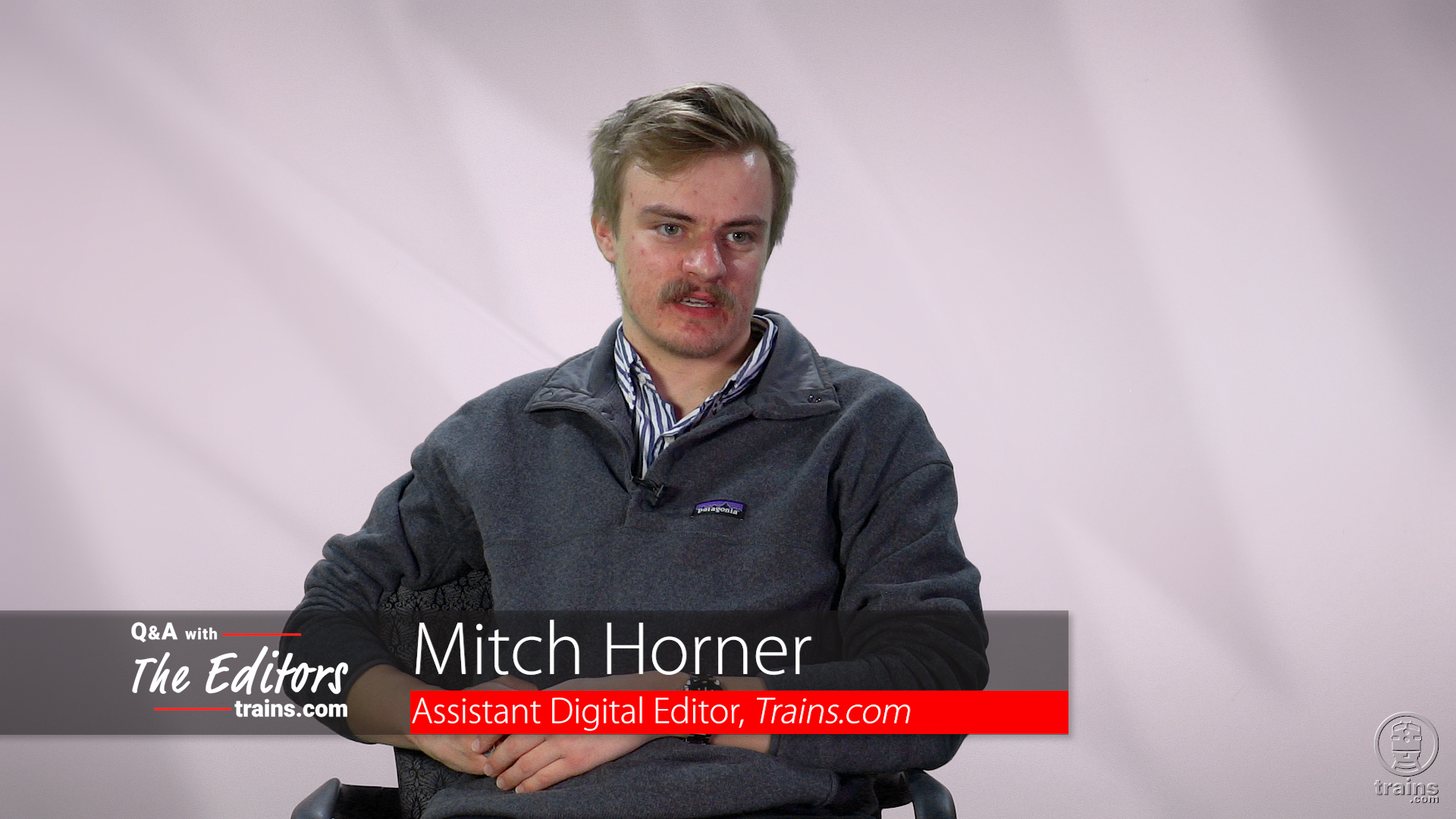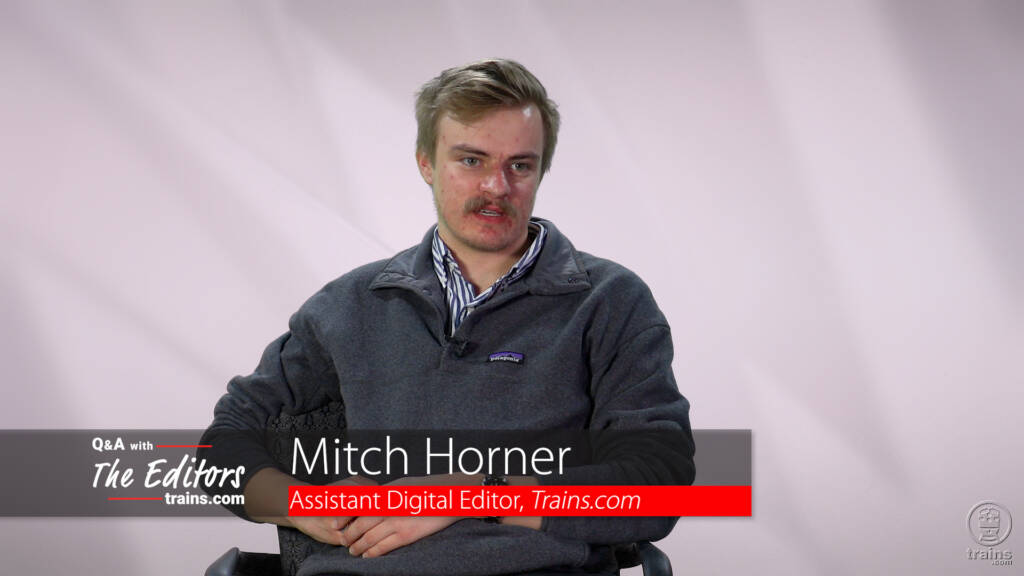Meet Mitch Horner, Trains.com Assistant Digital Editor in this Q&A with the Editors. Trains.com Unlimited Members can see the video in the Trains.com Video section.

Steve Sweeney: Ladies and gentlemen, welcome to another episode of Q&A with the Editors. We’re so glad to have Mitch Horner today, from Model Railroader. Mitch, how are you doing?
Mitch Horner: Doing well, Steve. Yourself?
SS: Not bad, thank you. For those of you who do not know Mitch. Mitch, could you introduce yourself to our audience?
MH: Yeah, of course.
SS: And just tell us how you came by Model Railroader.
MH: I’m a relatively new editor with MR. I came to the publication here, not necessarily through any particular modeling skill, but through a passion for writing and editing and the written language. I graduated in 2021 with a degree in English and a degree in film studies, and I found myself here towards the end of last year, and it’s been it’s been a great ride ever since.
SS: Fantastic. Well, welcome. We have five questions that we typically ask everyone. So, if you don’t mind, I’d like to start asking you those.
MH: Of course.
SS: Fantastic. So, what is your favorite railroad, past or present, and why?
MH: Got to be the Milwaukee Road. It’s the hometown railroad, there’s a very interesting history behind it, and there’s a lot of good information out there. I’ve talked with a lot of people who are very passionate about it prior to even starting here. And for as long as I’ve had an interest in trains and railroads, that’s been my go-to.
SS: What is the best part about what you do?
MH: Most people in the building would probably say that they enjoy the modeling projects, sort of the more hands-on technical building things. There are a lot of people who would find a lot to appreciate in the railroads and being able to do hands-on things with that. But I like getting my hands dirty with the writing and editing. That’s what I’m best at, that’s what I have interest in, and that’s where my academic past lies. It’s very fulfilling to be able to work in this field, and I’ve really enjoyed it so far.
SS: That’s great. Mitch, I want to add to that and ask you is that one of your passions is cinema. We’ve had a lot of interesting discussions over time about cinema in general, but what we really haven’t gotten too much to talk about are railroads in movies. And I’m sure you’re familiar with a few. Are there any that come to mind as particular greats for you?
MH: I think John Frankenheimer’s 1964 feature The Train.
SS: Burt Lancaster.
MH: With Burt Lancaster, exactly. It’s a masterpiece, it’s a fascinating movie, and everything you see on the screen is real. When they blow up a train depot in France, they’re actually blowing up a very old train depot that was slated for demolition anyway. When one train crashes into another train, it’s two trains actually crashing into each other. You get a real sense of scale from that. It really feels big, and it feels weighty. A lot of times in movies of the period, you see what are somewhat clearly scale trains and model trains crashing into one another, but you don’t get that feeling at all with The Train.
Also, the entirety of the Western genre is more or less predicated around trains in a big way, spaghetti westerns especially. Sergio Leone’s Once Upon a Time in the West is probably the best example of that. That’s all about the expansion westward of the railroads and everything that happens alongside that movie is really motivated by this expansion westward by the railroads. And that becomes evident even from the first scene, starting off at that train depot on the platform as Charles Bronson steps off the train. It really it introduces you and you know what you’re getting into with that.
SS: Have you seen any of the more recent movies with trains or railroads in them? I’m thinking in particular of the movie that came out in 2022 of the Japanese Bullet Train. I think it was just Bullet Train.
MH: Was that the Brad Pitt one?
SS: It was the Brad Pitt movie.
MH: It was interesting. I like Brad Pitt, but I didn’t think that made the best use of him. And I thought that it kind of underutilized the train itself. I would have appreciated it more if they filmed on a real bullet train. There are some times when they’re doing things that you feasibly can’t actually achieve with the bullet train, filming practically. But it would have been a nice touch, I thought. I know it was it was very well-liked for the most part.
SS: Well, perhaps they’ll think of it next time after seeing this clip.
MH: Yeah, clearly, they should consult with me.
SS: Absolutely. Mitch, tell us about something exciting you’ve been working on lately.
MH: I’ve been working on my first real modeling project since I was a kid. I’ve been putting together a structure kit for the upcoming project layout, which has been interesting, kind of getting my hands dirty in that regard. It’s been fulfilling and definitely learning a lot. There are a lot of very experienced modelers, David Popp has been helping me out and learning a lot in that field.
In terms of writing, I’ve been doing a lot of video transcription articles. I guess you could call them grunt work, but it’s work that someone has to do, one way or another. There are some interesting ways that you can kind of work the transcriptions into an article that stands alone from the video.
I’ve been writing some of my own articles as well, and in doing so, actually learning a lot. You say the best way to learn is to learn hands-on. And being able to actually write about all these different modeling topics are helping me to get a better understanding of things than I otherwise wouldn’t.
SS: So, a fun question that we do ask everyone is if you were working for the railroad, what railroad craft that is labor or position generally do you think best describes you?
MH: I had to consult with Bryson on this one because I don’t know too many railroad jobs and he got me pointed in the right direction. I like to believe that I would be doing something similar to what I do now.
SS: Okay.
MH: A railroad is a business like any other. A business of that size needs writers, they need copywriters, they need copy editors, and they need press people. I think – personally with my background and my skill set – that’s probably where I would find myself. Writing press releases, copywriting, advertising, something along those lines.
SS: And so, as we wrap up, Mitch, is there anything that you thought I should have asked you that I did not? Is there anything that you’d like to reiterate or anything that you’d like to add at all?
MH: Yeah, I’d like to give a special shout-out to the first Mission Impossible movie, which has a wonderful culmination of Tom Cruise flying a helicopter into an English bullet train tunnel, and then jumping from the helicopter onto the train. There’s nothing that he can’t do.
SS: In the movies.
MH: Yeah, well, it’s becoming increasingly real for him as he throws himself off of Parisian buildings and Norwegian mountains while on motorcycles with parachutes. One of these days, it’s going to catch up with him.
SS: One of these days, but not today.
MH: Hopefully not. We got two more Mission Impossible movies we got to get out of him at the very least.
SS: Fair enough. Mitch, thank you for joining us today.
MH: Thank you for having me.

